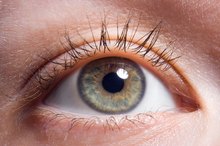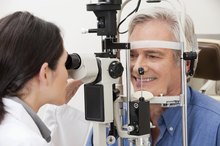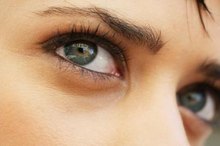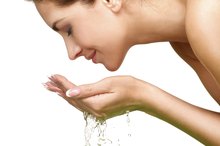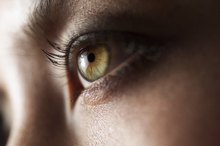Brown Spots on the Eye
Freckles, small accumulations of melanin or pigment, appear anywhere on the skin and sometimes in the eye, accounting for the majority of eye spots. In most cases, an eye freckle can only be seen by an opthalmologist. This is especially true if the freckle occurs inside the colored portion, or the iris, of the eye. When the freckle appears on the sclera, or white part of the eye, it shows up as a brown spot.
Appearance
Eye freckles, also called choroidal nevus, vary according to size and color. Most people never know that they have one unless their ophthalmologist tells them. However, they can get large enough to become easily visible to the naked eye. The color ranges from a light gray to brown or black.
- Eye freckles, also called choroidal nevus, vary according to size and color.
Cause
Dark Spots on the White of the Eye
Learn More
The eye possesses a membrane full of pigment cells called the choroid. While the reason is not clear, the pigment cells can clump together abnormally, resulting in an eye freckle. Rarely, eye freckles are present at birth. Usually, they develop at the same time as skin freckles.
- The eye possesses a membrane full of pigment cells called the choroid.
- While the reason is not clear, the pigment cells can clump together abnormally, resulting in an eye freckle.
Treatment
Because brown spots rarely cause trouble, they do not need to be treated, according to Alice Langholt, writing for Life 123. When spots are troublesome, they are treated through laser surgery, radiation therapy or a combination of the two. As of 2010, no cosmetic treatment exists to remove or reduce the appearance of a visible eye freckle.
Tests
How to Remove Brown Spots on Sclera
Learn More
Your opthalmologist may choose to inspect or run some tests on a suspicious or new choroid nevus. During the examination, your doctor will look closely at the spot and at the blood vessels surrounding the spot with a special procedure called a fluorescein angiogram. This procedure allows the doctor to take pictures of the freckle from the back of your eye. Your doctor will also watch the spot for changes in size and shape over time.
- Your opthalmologist may choose to inspect or run some tests on a suspicious or new choroid nevus.
- This procedure allows the doctor to take pictures of the freckle from the back of your eye.
Considerations
Approximately 5 to 10 percent of people have a choroidal nevi. Most occurances are benign. Only about one out of 20,000 turn out to be cancerous, according to Retina Vitreous Associates of Florida.
Related Articles
References
- Chester F. Carlson Center for Imaging Science: Parts of the Eye
- Facts about Eyes: Got an Eye Freckle?
- Ocular Melanoma Foundation. Understanding choroidal nevi.
- New York Eye Cancer Center. Choroidal nevus.
- Sowka, Joseph W. OD, FAAO, Andrew S. Gurwood, OD, FAAO, and Alan G. Kabat, OD, FAAO. Handbook of Ocular Disease Management, Choroidal Nevus. 2000-2001.
Writer Bio
Kathy Mayse began her writing career as a reporter for "The Jackson-County Times Journal" in 2001. She was promoted to assistant editor shortly after. Since 2005, she has been busy as a successful freelancer specializing in Web content. Mayse is a licensed cosmetologist with more than 17 years of salon experience; most of her writing projects reflect this experience.

